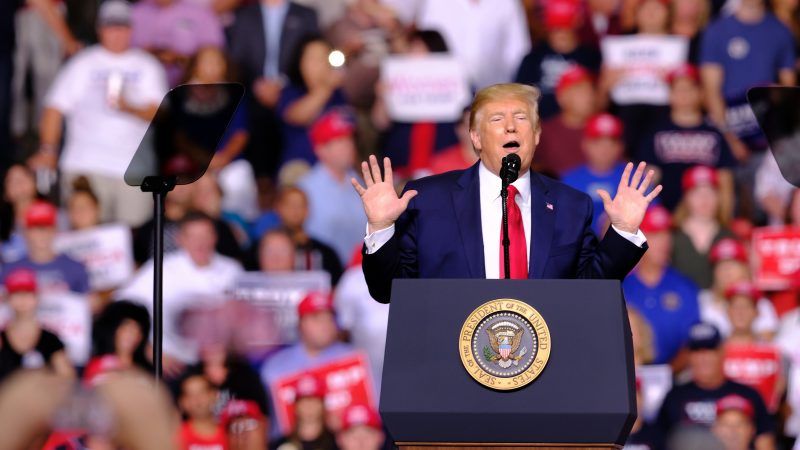Did Trump's 2016 Rallies Trigger a 226% Increase in Local Hate Crimes? Not Exactly.
The study at the source of the viral headline was limited to counting anti-Semitic incidents, many of which were not criminal in nature.

Last March, a number of media outlets—including The Washington Post, Business Insider, Vox, and The Hill—reported a startling figure: During the 2016 campaign, U.S. counties in which candidate Donald Trump held a political rally experienced a 226 percent increase in hate crimes over those that did not.
The Post reupped this claim in a recent article, and numerous Trump-critical politicians—including Sen. Bernie Sanders (D–Vt.) and Rep. Ilhan Omar (D–Minn.)—seized upon it. "Mr. President: stop your racist, hateful and anti-immigrant rhetoric," wrote Sanders in a Facebook post that referenced the statistic. "Your language creates a climate which emboldens violent extremists."
But much like the unsupported idea that the hate crime rate is higher than ever, the 226 percent statistic doesn't quite stand up to scrutiny.
The source of the statistic is a study by political scientists Ayal Feinberg, Regina Branton, and Valerie Martinez-Ebers. The trio co-authored the initial Post story, which ran under the title "Counties that hosted a 2016 Trump rally saw a 226 percent increase in hate crimes." This headline misrepresents the study's findings. Trump's appearance did not cause counties to suddenly experience 226 percent more hate crimes—rather, counties that hosted Trump rallies experienced 3.26 times as many incidents as other counties, a 226 percent difference.
And those incidents, in turn, were not all hate crimes. The authors' sole source of data is the Anti-Defamation League's 2016 report on hate, extremism, anti-Semitism, and terrorism. This lists 1,321 anti-Semitic incidents reported to the organization in 2016. There are two important things to keep in mind here: 1) the list's focus is anti-Semitism, and 2) many of the incidents on the list are not actually hate crimes.
The first point matters because many people have interpreted this study's findings as proof of the notion that Trump's odious comments about immigrants and Muslims ("shithole countries," the travel ban, etc.) correspond with a spike in hate crimes committed against these groups. The Associated Press's coverage of the 226 percent statistic, for instance, begins by noting that "President Donald Trump has often railed about an 'invasion of illegals' at the southern border, words echoed in a screed the El Paso shooting suspect apparently posted that called the attack that killed 22 people at a Walmart his response to a 'Hispanic invasion of Texas.'" It's certainly conceivable that Trump's anti-immigrant rhetoric could prompt an increase in hate crimes against them, but this study doesn't really test such a proposition, as it is almost exclusively focused on anti-Semitic acts.
The second point is important because "hate crime" is a very specific category that requires the perpetrator to have committed a crime—assault, vandalism, etc.—for reasons of animus toward a marginalized group. The ADL counts all sorts of anti-Semitic speech—vile stuff, to be sure, but much of it non-criminal. A great many incidents on the ADL's list are schoolyard bullying, for example. According to this study, Trump's political rallies are correlated with a significant spike in these kinds of incidents, but that's not as strong a finding as the headlines suggest.
The ADL dataset, by the way, is compiled using "news and media reports, government documents (including police reports), victim reports, extremist-related sources and Center on Extremism investigations." Greater public interest in reporting on these kinds of incidents could result in a perceived increase. The list is naturally selective, and incomplete: There are more than 3,000 counties in the U.S., and the ADL counted just 1,321 incidents in 2016. A "226 percent increase" sounds like a lot, but we're talking about less than one hate crime per county on average.
When I reached out to the study's authors some months ago, Feinberg explained that the study had not yet been peer reviewed, and thus he couldn't release it to me. (This was frustrating, given that the study's findings were already being reported as if they were unimpeachable.) But after the second round of media coverage, Feinberg's team released it.
When I raised some of these issues with him—that anti-Semitic incidents are not necessarily hate crimes, in particular—he replied that "as a result of queries like yours," his team would be re-running the numbers. This time they intend to use the FBI's Uniform Crime Reporting database, which compiles statistics on hate crimes.
"The trump rally coefficient is both significant and directionally consistent with the ADL data," Feinberg assured me. His team plans to release the updated findings in the near future.
The FBI's database has a significant flaw of its own: Not all police jurisdictions participate in it, and thus its overall portrait of an ever-increasing hate-crime rate may well be misleading. Perhaps it could be a more useful vehicle for county-to-county comparisons than the ADL figures, but with the important caveat that there are some areas of the country that don't submit data at all. While I look forward to parsing the new results, it will still be important to interpret them with the appropriate levels of salt.



Show Comments (39)